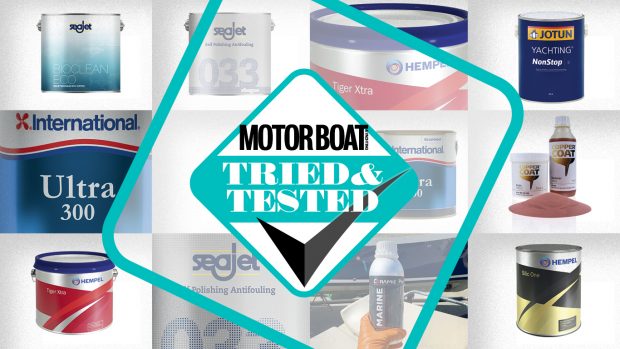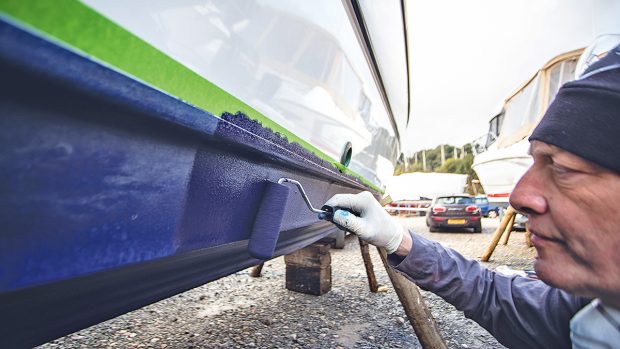A dozen of the leading antifouling paints are put to the test and rated by MBY in The Solent and the Mediterranean
The antifouling answer depends on a variety of factors including what type of boat you have, how often you use it and where you keep your boat. That’s why we’ve tried to take the guesswork out of it by looking into the science of how they work then testing a wide range of different paints in three different locations around the UK and the Mediterranean, and rating them for durability and colour fastness as well as how they performed against slime, barnacles and weed.
Types of antifouling paint
There are plenty of misconceptions when it comes to antifouling, even the question of whether to choose a hard or soft paint isn’t as straightforward as it seems, as Darren Gittens of Hempel Paint points out: “Motorboat owners often think that they need a hard paint just because their boat is capable of 30 knots but that’s not always the case. If you regularly exceed 25 knots when cruising or 80 hours total use per year, then you need a hard paint, if you don’t then you’re better off with a soft eroding paint.”
Kate Moss, new product chemist at AkzoNobel the company behind the International range of antifouling coatings, shed more light on the subject: “Most antifouling paints for motorboats are designed to use the friction of water passing over the hull to clean the growth off and erode the paint surface, but unless you take your boat out every other weekend, you could be better off with a paint for a sailing boat.”
There are five main types of antifouling paint, and what suits your boat depends on how you plan to use it. Most products use a similar combination of biocides to keep the fouling at bay so the key differences are in the structure of the paint that delivers these biocides. Over time the biocides leach out of the exposed paint surface leaving an inert coating which can no longer repel fouling. The trick is to ensure that layer of dead paint is removed either by a physical or chemical process in order to expose a fresh layer of bicocide laden paint.
Soft Rosin-based eroding paint
This uses a soft soluble binder that gradually dissolves in water leaving a fresh layer of paint and biocide. This means the thickness of the paint gradually reduces until it eventually disappears altogether. This type of paint suits sailing yachts and displacement motor boats but may wear out too quickly if applied to a fast planning boat that is regularly driven at speeds of 40 knots or more.
Self-Polishing paints
Self-polishing works in a very similar way to the self-eroding paint but uses a mix of soluble and insoluble glues that requires at least a tidal flow of water passing across the paint to wear it down, revealing the fresh layer beneath. This type of paint won’t go off if the boat is out of the water. Stronger binder means that it can be used on fast boats provided they don’t regularly exceed 25 knots.
CoPolymer
CoPolymer paint replaced the notorious tin based TBT that was banned in the 1990s when it was discovered that it caused some microrganisms to change sex. Unlike the previous paints, the acrylic binder reacts to salt in the water continuously exposing a fresh layer of biocide laden paint. This means that it is not reliant on any movement of water and works regardless of whether the boat is lying idle in the marina or cruising regularly.
Hard paint
Hard paint is most effective the first day after launching but as the season passes the bicocides leach out and it gradually becomes less effective. If the boat is removed from the water after launch, it can also form an impermeable layer which prevents any further biocide leaching out even when launched again. Hard paint is popular on racing yachts and fast planning motor boats as it can be sanded smooth for reduced friction and won’t erode too quickly at speed. This also means it’s more prone to paint build up over the years which may need removing at some point to prevent it cracking and peeling.
Silicon paints
Rather than using biocide chemicals to stop growth, they form a super slippery surface that prevents fouling from getting a solid grip on the surface. Some growth will still appear when left unused in the marina but as soon as the boat exceeds eight knots any significant growth should wash off. They also claim to reduce friction in the water, increasing efficiency and speed. The downside is that it has to be applied to a properly prepared gel coat (any old antifouling has to be stripped off) and it can’t be painted over if you ever decide to switch back to a conventional antifouling paint. .
Paint legislation
The UK is currently in the mid-way between Mediterranean and Nordic countries in terms of legislation. Mediterranean countries are far more lax in terms of what can be used, and who can do it. The story is the opposite in the Nordic area, with some paints that are available in the UK being banned. It continues with removal too, with specialist sites that wash, drain and filter all residue being mandatory when working with antifouling. While nothing is set in stone for UK shores, it’s worth noting that changes that affect us all could be just around the corner.
What are we looking for?
In this test we are not necessarily looking for the cleanest panel at the end of the test, but one that is strong enough to withstand use in the real world, while not succumbing to growth when left in the marina. We also wanted to see how the new environmentally friendly silicone paints performed against more traditional biocide based paints. Finally, one of the biggest niggles with antifouling paint is the way the original colour can fade or change over time. This is particularly true of light colours such as white or cream which often turn green around the waterline due to the copper oxide content.
Some of the paints that we’ve tested are for professional application, and wherever that’s the case we’ve made that clear.

Greg Goulding conducts MBY’s antifouling test
How we tested them
To ensure our testing methodology was as accurate and reliable as possible we based it on advice from industry experts both before and during the test.
We picked three different locations to conduct our testing, one on the East Coast, one in the Solent and one in the Mediterranean and prepared separate boards for each area. The boards were made from marine plywood, sealed with oil-based paint to replicate the gel coat of the hull and then primed using an industry standard primer.
The board was marked out with 10 defined areas and a different antifoul paint applied to each strip. The two silicon based paints were applied to two smaller boards as we wanted to monitor these separately. The test panels were then left in our chosen locations over the 2015 season.
The two UK locations are tidal, so had a constant knot or two running past, while the Mediterranean location was a marina on the Spanish coast, giving us real world results.
Once lifted, we studied the colour change, fouling build-up and type of growth. We then ran a finger over each panel to see how securely the fouling was attached and whether it might wash off on a planing boat with regular cruising at 20 knots or more. Finally we washed each board to replicate a scrub and see how well the fouling and the paint lasted.
Static board tests are often criticised for only portraying boats that are left in the marina untouched for the entire season. However, this is still the preferred method of conventional antifouling paint manufacturers as most boats are left in the water all season, only going out a handful of times and rarely being driven hard for more than a few minutes at a time.









